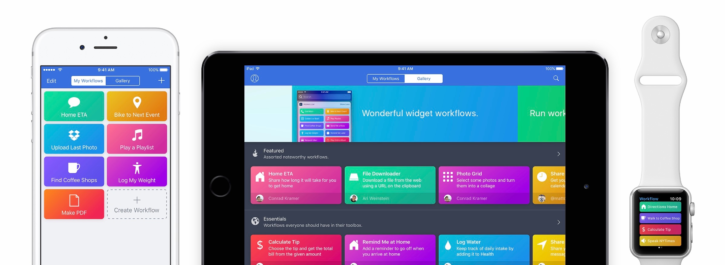is a blog about design, technology and culture written by Khoi Vinh, and has been more or less continuously published since December 2000 in New York City. Khoi is currently Principal Designer at Adobe, Design Chair at Wildcard and co-founder of Kidpost. Previously, Khoi was co-founder and CEO of Mixel (acquired by Etsy, Inc.), Design Director of The New York Times Online, and co-founder of the design studio Behavior, LLC. He is the author of “Ordering Disorder: Grid Principles for Web Design,” and was named one of Fast Company’s “fifty most influential designers in America.” Khoi lives in Crown Heights, Brooklyn with his wife and three children. Refer to the advertising and sponsorship page for inquiries.
+Apple Acquires Workflow and the Future Looks Bright

As reported by TechCrunch today, Apple has acquired the powerful iOS automation app Workflow. I’m pretty enthusiastic about this, and not just because I’ve basically been crazy for this app since I first started tinkering with it late last year. There are some exciting larger implications to this news.
Unlike many Apple acquisitions, this one was not just a deal for the Workflow team but for the app itself too, which signals that Apple sees value in the product. And how could they not? What the team has built is remarkably robust for any platform, but especially for a platform like iOS which isn’t exactly known for its openness. Most iOS users accustomed to the relatively siloed nature of the apps on their iPhone or iPad would probably be surprised to see how freely Workflow moves data between them, and how powerfully it can automate apps and services that otherwise seem blithely unaware of one another.
It now seems apparent that Apple intends to make iOS itself more open to Workflow-style automation, not less, and that’s a good thing. The kind of customization that Workflow allows is critical for the iPad, particularly, if it’s to become a true productivity platform. (In fact, Workflow made writing this blog post and assembling the imagery on my iPad even more efficient than it would have been on my MacBook.)
But this move also hints at what the future of Apple’s strategy for Siri, smart assistants and home automation might be. It wouldn’t be unreasonable to guess that Workflow could play a key role as an elegant, easy-to-learn scripting environment for many if not all of Apple’s future endeavors in cloud-connected, AI-powered, voice-enabled platforms. When you look at competitors like Amazon’s Alexa platform, Google Assistant, Cortana, etc., they all lack a truly elegant, easy-to-master entryway for casual users who want to customize their experiences—and that’s exactly what Workflow gives Apple. (Though don’t be surprised if these other players acquire Zapier or IFTTT soon as well.)
I do have one concern about today’s news though and that is that Workflow itself may eventually become neglected as its core technology and approach is integrated into other Apple initiatives. The app is superb today for what it is, but it could still be so much more even as “just” a way to automate your iPhone or iPad. Now that it’s no longer a third-party app, the team presumably will have access to private APIs that it never did before, which dramatically increases the possibilities of what it might one day allow users to do, if Apple allows it
Finally, if you haven’t tried Workflow yet, there’s now absolutely no reason not to, as Apple has made the app free starting today. No better time than the present to start living the future.
+